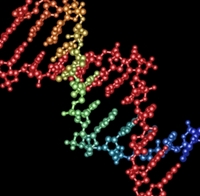Editing the genome with high precision
By By Anne Trafton, MIT News Office | 05 Jan 2013
Researchers at MIT, the Broad Institute and Rockefeller University have developed a new technique for precisely altering the genomes of living cells by adding or deleting genes. The researchers say the technology could offer an easy-to-use, less-expensive way to engineer organisms that produce biofuels; to design animal models to study human disease; and to develop new therapies, among other potential applications.
 To create their new genome-editing technique, the researchers modified a set of bacterial proteins that normally defend against viral invaders. Using this system, scientists can alter several genome sites simultaneously and can achieve much greater control over where new genes are inserted, says Feng Zhang, an assistant professor of brain and cognitive sciences at MIT and leader of the research team.
To create their new genome-editing technique, the researchers modified a set of bacterial proteins that normally defend against viral invaders. Using this system, scientists can alter several genome sites simultaneously and can achieve much greater control over where new genes are inserted, says Feng Zhang, an assistant professor of brain and cognitive sciences at MIT and leader of the research team.
''Anything that requires engineering of an organism to put in new genes or to modify what's in the genome will be able to benefit from this,'' says Zhang, who is a core member of the Broad Institute and MIT's McGovern Institute for Brain Research.
Zhang and his colleagues describe the new technique in the 3 January online edition of Science. Lead authors of the paper are graduate students Le Cong and Ann Ran.
Early efforts
The first genetically altered mice were created in the 1980s by adding small pieces of DNA to mouse embryonic cells. This method is now widely used to create transgenic mice for the study of human disease, but, because it inserts DNA randomly in the genome, researchers can't target the newly delivered genes to replace existing ones.
In recent years, scientists have sought more precise ways to edit the genome. One such method, known as homologous recombination, involves delivering a piece of DNA that includes the gene of interest flanked by sequences that match the genome region where the gene is to be inserted. However, this technique's success rate is very low because the natural recombination process is rare in normal cells.













.jpg)






.jpg)









